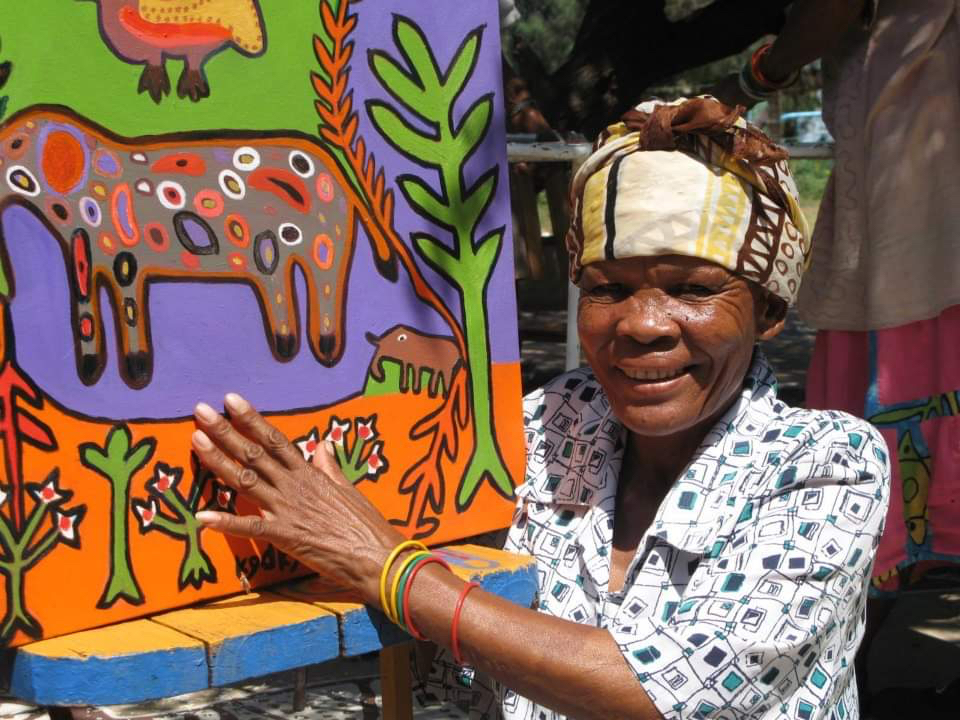- Book is bound in goat skin tanned in the traditional method of the San.
- Makes the list of 10 highlights of the exhibition
GOSEGO MOTSUMI
This past week, a book titled “Qauqaua” that contains works by San artists of the Kgalagadi was on display at the Bonne Espérance Gallery in Paris where it was listed by The Gro-lier Book Club as one of the top 10 highlights of the exhibition.
The book – the first printed in the pre-dominant San language of the Kgalagadi, Naro – tells a traditional San folktale. It was a part of the Smithsonian Institute’s permanent collection. “This is a proud first moment for the book and some works by artists from the Kuru project to be exhibited in France,” says the Man-ager of Kuru Art, Maude Brown.
“For us this means that our stories are told to the international audience. Had it not been for the disruptions brought on by COVID-19, the gallery would have wanted a bigger exhibition and the col-lectors suggested a bigger exhibition the next time because they are interested in the art.”
In 1994, the Kuru Art Project, in collaboration with The Artists Press, produced the limited edition artists’ book Qauqaua, which is a San folk story told by Coexae Qgam. This is the first book ever written in a San language, told by a San people, illustrated by San artists and bound in goat skin tanned in the traditional method of the San.
It contains 11 hand printed lithographs signed by the artists – etchings and some-times pencil drawings or painted elements. The book is a limited edition art-work produced by a collective and has aspects of handmade work in it.
“Mark Attwood of The Artists Press has always worked with the artists. In 1994, he worked on a collaborative workshop with the artists at their studio at D’Kar, proofing the litho plates on an etching process. The drawn plates were taken to Johannesburg where the edition was printed. He owns an edition and I guess that is how the book landed in the world’s most prestigious galleries,” says Brown:
Lying on a pan of fragmented rock close to the Botswana border with Namibia is a small boulder that looks so different from the surrounding jagged landscape that it appears as if it must somehow have been placed there. The BaSarwa or San living in the nearby village of D’Kar talk of this rock as being the body of Qauqaua, a folk heroine.
The artists of the Kuru Art Project grew up with the Qauqaua folktale that has been told and retold by parents and grandparents. With their traditional way of life changing so rapidly around them, they have decided to preserve this story in book form.
Thamae Setshogo, Coex’ae Ogam, Qwaa Mangana, Cgose Ncoxo, Sobe Sobe, Nxabe Eland, Coex’ae Bob Qhaeqhao Moses, and Thama kase have worked primarily with oil on canvas on the edition. . The folktale was written down in Naro by Hessel and Cobi and translated into English by staff of Kuru Cultural Centre.
Since 1990, the Kuru Art Project has supported the cultural identity of San artists in the Kgalagadi and provided an avenue for the artists to generate an income. Artists participating in the Kuru Art Project use a variety of techniques: oil paint on canvas, linocuts, lithographs and dry point engravings. Craft producers use traditional techniques to create ostrich eggshell jewellery, paint and print textiles, embroidery and applique.

